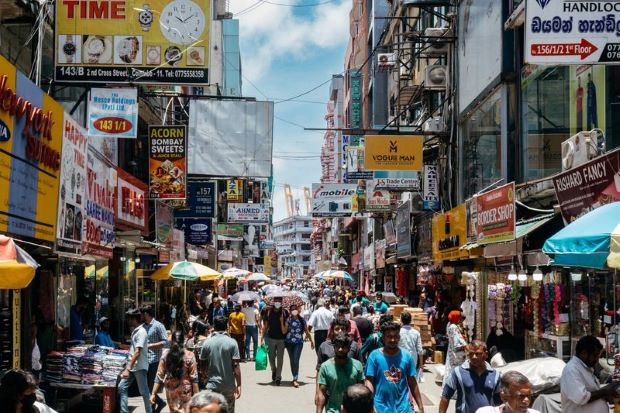Sri Lanka’s economic recovery ‘incomplete’, poverty remains twice 2019 levels, World Bank warns

Growth projected at 4.6% for 2025, but structural weaknesses and elevated poverty threaten sustainability, new report finds
COLOMBO – Sri Lanka’s economy has rebounded from its worst crisis in decades, but the recovery remains fragile and incomplete, with poverty levels still double their pre-crisis rates and economic output below 2018 benchmarks, the World Bank cautioned in a stark assessment released Tuesday (7).
The warning comes as the international financial institution projects modest growth of 4.6% for 2025, driven by a rebound in industry and steady services expansion, before slowing to 3.5% in 2026 – a trajectory the bank says remains vulnerable to both global economic uncertainty and persistent domestic structural weaknesses.
“While Sri Lanka’s recent economic progress is encouraging, the recovery is uneven and incomplete,” said David Sislen, World Bank Country Director for Maldives, Nepal, and Sri Lanka, at the launch of the latest Sri Lanka Development Update (SLDU) titled ‘Better Spending for All.’
“To build a stronger, fairer economy that benefits all households, Sri Lanka needs private sector investment, job creation, and efficient, well-targeted public spending,” he added.
The assessment reveals troubling gaps in the nation’s post-crisis trajectory. Despite lower inflation and improved external inflows following the 2022 economic collapse, Sri Lanka’s total economic output has yet to recover to 2018 levels, a lost half-decade of growth that has left deep scars on household welfare.
Food prices remain stubbornly elevated, foreign reserve accumulation has slowed considerably, and while poverty rates have declined from their crisis peak, they remain approximately twice as high as 2019 levels, before the pandemic and economic meltdown devastated livelihoods across the island.
The World Bank highlights that many households have not fully regained the livelihoods lost during the economic crisis, with approximately 10% of the population living precariously just above the poverty line, a vulnerable group at risk of falling back into destitution with any economic shock.
Malnutrition remains a pressing concern, particularly among women and children, the report notes, pointing to the crisis’s lasting impact on food security and health outcomes.
The labour market recovery has also lagged expectations, with limited job creation outside the informal sector. Public confidence in economic stability remains fragile three years after the 2022 crisis that saw soaring inflation, fuel shortages, and political upheaval that ultimately forced the resignation of then-President Gotabaya Rajapaksa.
To sustain growth and reduce poverty amid ongoing fiscal constraints imposed by Sri Lanka’s $2.9 billion IMF bailout program, the World Bank has called for a comprehensive package of structural reforms aimed at enabling private sector-led development. Key recommendations include easing barriers to trade and investment to boost competitiveness; modernizing tax administration to broaden the revenue base; reforming restrictive land and labour regulations; and improving the business environment to attract both domestic and foreign investment
“Sri Lanka’s path to recovery depends on restoring confidence, deepening structural reforms, and ensuring fiscal discipline to maintain stability,” the report emphasizes.
The Development Update places particular focus on public expenditure efficiency, revealing that over 80% of government spending is consumed by public sector salaries, welfare programs, and debt interest payments, leaving minimal fiscal room for critical investments in infrastructure, healthcare, and education.
With limited capacity to either expand or significantly reduce total spending under IMF program constraints, the World Bank has urged the government to fundamentally improve the quality and efficiency of existing expenditure rather than focusing solely on spending levels.
Specific recommendations include managing the public wage bill through fairer pay structures and modern payroll systems; prioritizing infrastructure projects that are nearly complete or address critical bottlenecks; enhancing project evaluation and monitoring systems to prevent the cost overruns and delays that have plagued major initiatives; and significantly increasing funding for infrastructure maintenance to sustain long-term productivity gains, an area historically neglected in favour of high-profile new projects
The Sri Lanka report was released alongside the broader South Asia Development Update titled ‘Jobs, AI, and Trade,’ which projects 6.6% growth across the region for 2025 but warns of potential slowdowns ahead.
The regional analysis stresses that reforms promoting trade openness and artificial intelligence adoption could help South Asian countries create much-needed jobs and catalyze more inclusive growth patterns—themes echoed in the Sri Lanka-specific recommendations.
The World Bank’s assessment concludes with a cautiously optimistic but heavily conditional outlook for Sri Lanka’s economic future.
Growth prospects hinge critically on the government’s political will and capacity to implement deep structural reforms, manage mounting debt obligations responsibly, and fundamentally reorient public spending toward investments that deliver broad-based, equitable growth rather than narrow political patronage.
The warning comes as Sri Lanka approaches crucial debt restructuring negotiations with bilateral and private creditors, with the success of those talks likely to determine whether the current fragile recovery can be consolidated or risks sliding backwards.
-ENCL


Comments are closed, but trackbacks and pingbacks are open.